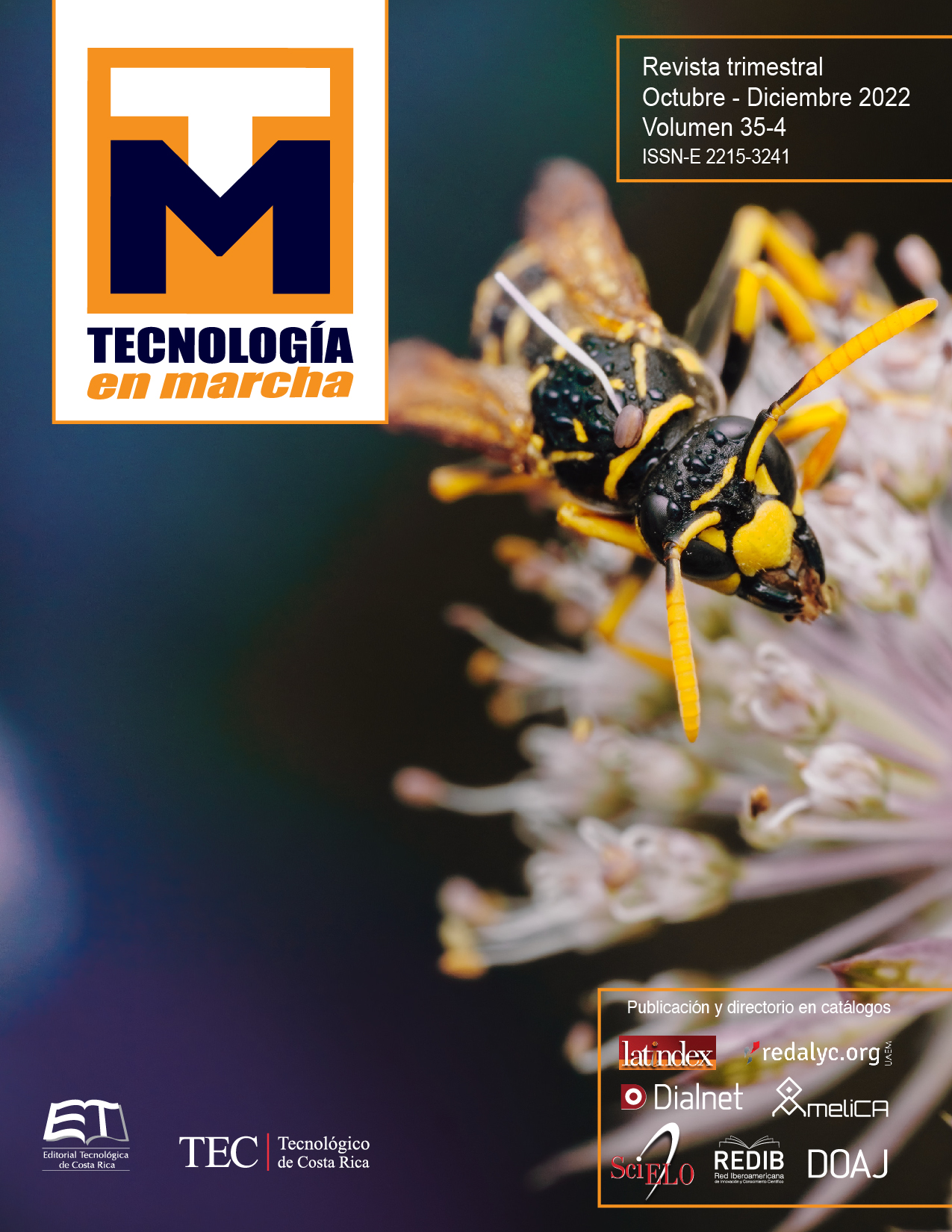Optimal determination in the extraction of hemicelluloses of high quality from Eucalyptus sp. sawdust, through hydrothermal treatment
Main Article Content
Abstract
Eucalyptus sp chips are one of the most important residues or by-products obtained from primary wood processing in the various regions worldwide [12]. Its main use is the production of energy [13]. When subjected to hydrothermal treatment conditions for the extraction of the hemicelluloses can extract the substances soluble in wáter [17], leaving a solid fraction of cellulose and lignin that will follow other processes of separation and use [11]. The waste material used was a mixture of Eucalyptusrostrata, E. grandis and E. Saligna with ages between 12 and 50 years, obtained in one of the sawmills of the region. The sample that was used in the experimental runs comprises the fraction that passes through the 20 mesh and is retained in 80 mesh inside a Zonytest manual sieve. Initially, a factorial design was applied to verify the influence of time (30, 45 and 60 min), temperature (120, 150 and 180 ° C) and liquid / solid ratio (5, 10, 15). This last variable was not significant. Afterwards, an optimization design was applied to the composite centered in the faces, varying the time (20, 30 and 40 min) and temperature (170, 180 and 190 ° C). The treatments were carried out in 200mL digesters in a glycerin bath. The best point obtained was validated with a scale change in a 4.6 L digester, with a heating jacket and a special stirring system. Temperature proved to be the most influential factor in the pretreatment of autohydrolysis of sawdust. The highest extraction of hemicelluloses (89% of initial hemicelluloses) was obtained at 190 ° C and 20 min, however to minimize the generation of furfural by optimizing multiple responses, the best condition was 180 ° C and 20 min. The response surface shows that similar results could be achieved at 170 ° C if the treatment time is extended to 50 min.
Article Details

This work is licensed under a Creative Commons Attribution-NonCommercial-NoDerivatives 4.0 International License.
Los autores conservan los derechos de autor y ceden a la revista el derecho de la primera publicación y pueda editarlo, reproducirlo, distribuirlo, exhibirlo y comunicarlo en el país y en el extranjero mediante medios impresos y electrónicos. Asimismo, asumen el compromiso sobre cualquier litigio o reclamación relacionada con derechos de propiedad intelectual, exonerando de responsabilidad a la Editorial Tecnológica de Costa Rica. Además, se establece que los autores pueden realizar otros acuerdos contractuales independientes y adicionales para la distribución no exclusiva de la versión del artículo publicado en esta revista (p. ej., incluirlo en un repositorio institucional o publicarlo en un libro) siempre que indiquen claramente que el trabajo se publicó por primera vez en esta revista.
References
ADRIASOLA, Biorefinería, 2012 En línea http://es.scribd.com/doc/57124676/Biorefineria-Jaime-Adriasola [Consultado: 12/12/2012].
M. Area y M. Vallejos., “Biorefinerías a partir de materias primas fibrosas”, Mari Papel & Corrugado, 21 (5), 45-48, 2012. ISSN 17943396.
M. Area, “Reportaje de capa: Biorefinaría industrial”, Revista O Papel, 30-36, 2011
J. Ariza, S. Caparrós y L. Jimenez, “Subproductos en la fabricación de pastas”. Autohidrólisis de las hemicelulosas. Córdoba, 2008.
Y.Arteaga y L. Carballo, Monografias, 2012 En línea: http://www.monografias.com/trabajos46/hemicelulosas-maderas/hemicelulosas-maderas2.shtml. [Consultado: 13/12/2012].
C. Becker, “Diseño compuesto de caras centradas”, 2012 En línea: http://www.oocities.org/ohcop/dcdcc.html [Consultado: 14/12/12].
B. Browning, “The chemistry of wood Interscience”, 687 p. Nueva York, 1990
L. Carballo, E. Cordero y U. Orea, Monografias, 2012 En línea: http://www.monografias.com/trabajos15/composicion-madera/composicion-madera.shtml#COMPEUCALIP [ Consultado: 13/12/2012].
C. Cardona y O. SÁNCHEZ, Journal: Fuel ethanol production: Process design trends and integration opportunities. Bioresource Technology 98:2415–2457, 2007
F. Felissia, M. Vallejos y M. Area, “Lignin recovery from spent liquors of sugar cane bagasse ethanol- water fractionation”, Cellulose Chemistry and Technology 9-10, 311-318 ISSN: 0576-9787, 2000.
G. Garrote, M. Eugenio, M. Díaz, J. Ariza y F. López, “Hydrothermal and pulp processing of Eucalyptus”, Bioresource Technology 88:61–68, 2003
I. Goldstein, “Productos químicos derivados de la madera”, 2012 En línea: http://www.fao.org/docrep/n5525s/n5525s01.htm [Consultado: 12/12/12].
C. Nuñez,” Química de la madera”, 2008 En línea www.cnunez.com.ar[Consultado: 15/12/12].
A. Sluiter, B. Hames, R. Ruiz, J. Scarlata y D. Templeton, “Determination of ash in biomass”. Normas (LAP). Technical Report NREL/TP-510-42622. National Renewable Energy Laboratory, 2008
A. Sluiter, B. Hames, R. Ruiz, J. Scarlata y D. Templeton, “Preparation of samples for compositional analysis”, Normas (LAP). Technical Report NREL/TP-510-42620. National Renewable Energy Laboratory, 2008
A. Sluiter, R. Ruiz,. J. Scarlata y D. Templeton,” Determination of extractives in biomass”. Normas (LAP). Technical Report NREL/TP-510-42622. National Renewable Energy Laboratory, 2008
A. Sluiter, C. Hyman y J. Wolfe, “Determination of insoluble solids in pretreated biomass material”, Normas (LAP). Technical Report NREL/TP-510-42627. National Renewable Energy Laboratory, 2008
TAPPI. 1996. Tappi Test Methods 1996 – 1997. Atlanta, Georgia. USA: TAPPI PRESS.
Y. Teramoto, “Pretreatment of eucalyptus wood chips for enzymatic saccharification using combined sulfuric acid-free ethanol cooking and ball milling”, Biotechnology & Bioengineering 99:75-85, 2008.
M. Vallejos, F. Felissia y M. Area, “Chemical and physico-chemical characterization of lignins obtained from the ethanol-water fractionation of bagasse”, BioResources 6 (2), 1158-1171, 2011.
M. Area, “Desafíos futuros: posibilidades de mejoras que nos brindará la nanocelulosa”, 2020.https://www.argentinaforestal.com/2020/09/24/desafios-futuros-posibilidades-de-mejoras-que-nos-brindara-la-nanocelulosa/: Argentina forestal.
A.Balea, J. Sanchéz, M. Monte, N. Merayo, C. Negro y A. Blanco, “In situ production and application of cellulose nanofibers to improve recycled paper production. Molecules”, 2019.
M. Delgado, “Nanotecnología en el sector papelero: Mejoras en calidad y permanencia de las fibras de alto rendimiento y secundarias en una economía circularmediante el uso de nanofibras y el refino enzimático”, 2015
N. Ehman, “Tesis Nanocelulosa a partir de residuos agro forestoindustriales”, 2019.
S. Tanpichai, S. Witayakran, Y. Srimarut, W. Woraprayote y Y.M, “Porosity, density and mechanical properties of the paper of steam exploded bamboo microfibers controlled by nanofibrillated cellulose”. J Master Res Technol, pp.3612-3622, 2019.
Q. Tarrés, M. Area, M. Vallejos, N. Ehman, M. Delgado y P. Mutjé, “Key role of anionic trash catching system on the efficiency of lignocellulose nanofibers in industrial recycled slurries”. Cellulose, pp. 357-366, 2018.

